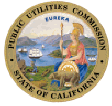 California Public Utilities Commission
California Public Utilities Commission
505 Van Ness Ave., San Francisco
_________________________________________________________________________________
FOR IMMEDIATE RELEASE PRESS RELEASE Media Contact: Terrie Prosper, 415.703.1366, news@cpuc.ca.gov
CPUC RENEWABLE ENERGY REPORT
HIGHLIGHTS PROGRAM SUCCESS
SAN FRANCISCO, February 3, 2012 - The California Public Utilities Commission (CPUC) today said that in 2011 the state's renewable energy efforts resulted in the greatest increase in renewable generation since the beginning of the program.
In its Renewables Portfolio Standard (RPS) 4th Quarter 2011 report to the state Legislature, the CPUC said that more than 830 megawatts of new renewable capacity came online in 2011, all of which was wind and solar photovoltaic projects. And, collectively, the state's large investor-owned utilities served 17 percent of their electricity with renewable energy in 2010.
Other highlights of the report include:
· In 2010, Pacific Gas and Electric Company served 15.9 percent of its electricity with renewable energy; Southern California Edison 19.3 percent; and San Diego Gas and Electric Company 11.9 percent. Per the compliance requirement the utilities are required to average 20 percent RPS between 2011-2013, which all three utilities are projected to attain.
· The investor-owned utilities submitted 68 contracts representing 4,525 megawatts of renewable generation in 2011. In the same time period, the CPUC approved 44 contracts representing 2,461 megawatts of renewable generation.
New to the report this year, per Senate Bill 836 (Padilla), is a section on the costs of electricity procurement contracts for eligible renewable energy resources and costs for utility-owned generation approved by the CPUC.
The report presents historical data on cost trends as the RPS program was first implemented. There was an increase in the cost of delivered renewable energy in 2008, which may be explained by two factors. First, most of the energy came from renewable "qualifying facilities," whose energy payments fluctuate based on the cost of natural gas, which was very high in 2008. Second, 2008 was a low hydroelectric year and as a result, low-cost hydroelectric generation did not factor into the average procurement costs to the same extent it did in other years.
In the beginning of the program, the utilities contracted with existing renewable facilities, allowing for lower costs. Over the course of the RPS program, in order to meet the 20 percent and 33 percent targets, the investor-owned utilities had to contract with new facilities, which require higher contract costs to recover the capital needed to develop a new facility. The weighted average time-of-delivery adjusted costs of all contracts approved ranged from 5.4 cents in 2003 to 13.3 cents per kilowatt-hour in 2011; the weighted average of all contracts approved in this time period was approximately 11.9 cents per kilowatt-hour. Most recently, bids from the 2011 RPS Solicitation, not yet available for inclusion in the report, show significantly lower costs, which will be reflected in future investor-owned utility contracts. Furthermore, contracts approved in 2011 represent contracts that began negotiations in 2009, and the renewable market has matured significantly since then, meaning that prices in future years will be lower still. The overall picture is that the renewable market is robust, competitive, and has matured since the start of the RPS program. Based on the current 2011 RPS Solicitation, costs are decreasing, making renewable energy more competitive with fossil fuels.
The RPS program was established in 2002 under Senate Bill 1078 (Sher) and modified in 2006 under Senate Bill 107 (Simitian). It requires investor-owned utilities, energy service providers, and community choice aggregators operating in California to obtain 20 percent of their retail sales from renewable energy sources by 2010. In 2011, Senate Bill 2 of the First Extraordinary Session (SB 2 (1x) (Simitian)) increased the renewable target to 33 percent by 2020 and required both retail sellers and publicly-owned utilities to achieve a 33 percent RPS.
The report is located under RPS Progress Reports at: www.cpuc.ca.gov/Renewables.
For more information on the CPUC, please visit www.cpuc.ca.gov.
###
